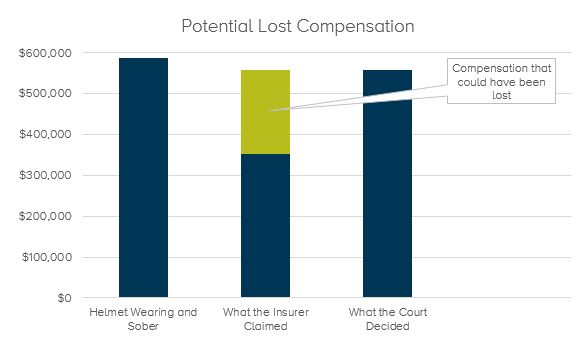
If a driver intentionally hits or runs a cyclist off the road, they are liable for that cyclist's injuries.
And depending on circumstances of the accident, that might be irrespective of whether the cyclist is drunk, helmetless, riding two-abreast or riding out of the cycle lane.
We can all agree riding drunk and without a helmet is illegal.
But according to the courts (and we tend to agree with them), these actions won't always reduce your compensation, so long as they don't contribute to the accident.
Find out how the courts came to that conclusion (in Nominal Defendant v Rooskov [2012]) and what a cyclist's legal rights are when they are drunk and helmetless.
Nigel's Story
Let me introduce you to Nigel Rooskov.
Nigel was an active young man.
It was a Wednesday evening, and he had knocked off work early. He decided to join his workmates for a few drinks and a roast lunch at the bowls club not far from his home in Helensburgh, NSW.
He was about 6 schooners deep when he went to head home. It was about 3:30 pm.
Nigel was heading down Walker Street when he was clipped by a white car travelling at about 80km/hr.
Forced onto the shoulder, Nigel then hit a ditch and was catapulted from his bike.
He suffered extensive back injuries and lacerations to his face and upper body. He also suffered significant head injuries as he wasn’t wearing a helmet at the time of the accident.
Nigel was in and out of consciousness when the police and ambulance arrived.
He could recall that a car approached him, and he heard screeching like a car trying to brake but not much else. However, he didn't know the registration details of the vehicle that caused the accident or even its colour or type.
...And the car never stopped to see if Nigel was okay.
Nigel wanted to bring a claim against the driver who hit him.
But what happens when the at-fault driver isn’t known? How can you get the compensation you deserve?
A body exists under the Motor Accident Insurance Act called the Nominal Defendant. This body acts as a compulsory third party (CTP) insurer where a negligent driver's motor vehicle is unidentified and does not have CTP insurance.
In other words, where a car cannot be found or identified or does not have CTP insurance, a claim for compensation can be brought against the Nominal Defendant.
Nigel brought a claim against the Nominal Defendant.
But Nigel's claim wasn't as straightforward as he first thought. At trial, liability was in contention.
It would come as no surprise that the insurer believed that Nigel should be held somewhat responsible for the accident and his injuries, being that he was riding drunk and helmetless.
The insurer (aka Nominal Defendant) argued that Nigel was 40% to blame for the crash and his injuries. And as such Nigel's compensation should be reduced by 40%
The Court was forced to consider two critical issues:
- Whether Nigel’s intoxication contributed to the crash; and
- Whether his decision to not wear a helmet contributed to his injuries.
The Issues
Alcohol
Nigel had consumed around 6 schooners of heavy beer before the crash.
An expert gave evidence at trial that his blood-alcohol level was likely in the range of 0.196 – 0.221g.
He went on to say that a person in that range was at least ten times more likely to suffer injury.
And while Nigel’s blood alcohol level was almost 4 times that of the legal limit, the Court believed that this didn’t contribute to the accident.
Why?
“In Court, the burden of proving a cyclist contributed to their injuries is on the at-fault party.
Simply put, it was up to the insurer to prove that:
1
Nigel’s drunkenness would have interfered with his judgement and2
that this caused his injuries.
While Nigel may have been able to speed up his reaction to hearing the approaching car, it wouldn’t have changed his course of action. He would still have been driven into the shoulder of the road and fallen from his bike.
In the end, the Court accepted that Nigel was intoxicated but agreed that:
- There was “no evidence” that this contributed to the crash; and
- Even if he were sober, he would not have likely responded any differently.

Nigel wasn't penalised because he was riding drunk. Do you think that's fair? Have your say below.
Helmet
But just because it's a statistic, it doesn't mean that the law or the courts will agree.
The Court believed that not wearing a helmet:
- did not contribute much to Nigel's injuries; and
- the damage that resulted from this decision was only 'miniscule'.

Cyclists are required to wear helmets by law. Do you believe that Nigel should have been punished for doing something illegal? Have your say below.
Why?
If you consider how the Court's establish contributory negligence, the Nominal Defendant had to prove the decision not to wear a helmet would have caused the accident and increased his risk of injury. Again, the burden of proof is on the insurer.
It is true that not wearing a helmet increased Nigel’s risk of a head injury.
However, and this is important, had Nigel put a helmet on, it would not have changed the course of action or reduced the likelihood of his other significant injuries.
The car would have approached Nigel at speed, hit him and caused him to fall off his bike.
He would still have suffered significant bodily harm (like his back injury), and this would still have impacted his ability to work and live.
The Court mostly agreed with Nigel’s argument.
Ultimately, the Court did accept that Nigel decision to not wear a helmet meant he was guilty of contributing to his injuries. But they said that he was only 5% to blame, rather than the 40% the insurer claimed.
His compensation was reduced by 5% to $557,442.18.
What does this mean for cyclists?
While we would never condone riding intoxicated or without a helmet, this case does show that the Courts will protect cyclist’s rights first and foremost.
Drivers cannot shirk their duty of care by using a cyclist's actions against them... so long as those actions don't contribute to the accident.
The Courts will assess a situation on a case by case basis. They will look at the bigger picture.
If a cyclist’s wrongdoings did not contribute to the accident, then they should not be penalised for them.
Cyclists who suffer psych injuries from repetitive close passes would do well to understand the position that Courts will take to protect riders.

Cyclist v Taxi
Land v Dhaliwhal & Anor is a 2012 decision out of the Supreme Court of Queensland.
In this matter the Plaintiff was awarded $380,000.00 in damages after colliding with a taxi and sustaining injury.
The Plaintiff cyclist had been cycling along Airport Drive, Eagle Farm, at the head of a group of cyclists who were training together. The Cyclists were riding on the part of the roadway adjacent to the left hand shoulder of the road, when a taxi, driven by the First Defendant, suddenly and without any warning veered into the lane directly in front of the Plaintiff and stopped almost immediately in front of where the Plaintiff was cycling.
Unable to avoid the taxi, the Plaintiff collided with the rear of the vehicle and sustained personal injuries, including a back injury and an aggravation injury to the knee.
Unfortunately, the Plaintiff’s injuries significantly restricted his ability to return to his pre-accident employment as the owner-manager of a Brisbane bicycle store and his ability to cycle. The Plaintiff was forced to hire additional staff to assist with the daily operation of the business and to allow him to attempt to recover from his injuries. Ultimately however, the Plaintiff was forced to sell his business and pursue a lighter and more manageable venture – he subsequently established another small business as a bicycle fitter which allowed him more freedom to change posture and work limited hours.
The Defendants, although admitting liability, alleged over the course of the claim that the Plaintiff was contributory negligent – that is, that he contributed to the incident and the injuries he sustained therein. Ultimately however, the Defendants conceded this point in their closing submissions at the trial and the Court escaped making a ruling on this particular point. The Court found in favour of the Plaintiff cyclist and awarded $380,000 by way of damages.
For more information please contact Emily Billiau

Hendricks v El-Dik & Insurance Australia Limited T/AS NRMA Insurance (No 4) [2016] ACTSC 160
This decision involved a Plaintiff cyclist who was injured when he was struck by a motor vehicle driven by the First Defendant.
The Plaintiff had been cycling home from his workplace. His route took him along a cycle path which included a section that cut across a number of driveways, including the driveway of the First Defendant motorist.
As the Plaintiff cyclist approached the driveway of the First Defendant, the First Defendant reversed out of his driveway and into the path of the Plaintiff cyclist – causing the Plaintiff cyclist to collide heavily with the passenger side of the vehicle.
Unfortunately, the Plaintiff’s head collided with the vehicle. The Plaintiff sustained significant spinal injuries and was rendered a quadriplegic.
Relevantly, the Plaintiff’s bicycle was fitted with a 500W capacity electric motor.
Although damages were agreed between the parties at $12 million, liability could not be agreed and the matter proceeded to trial.
The Defendants alleged that the Plaintiff cyclist was contributory negligent (that is, that they cyclist’s negligence contributed to the harm he suffered.) The alleged grounds of the Plaintiff’s contributory negligence were as follows:-
- Operating a registrable but unregistered bicycle powered by a 500W motor on the path;
- Travelling at an excessive speed;
- Failing to keep a proper lookout;
- Failing to have a horn installed on the bicycle; and
- Failing to deviate from the path rather than continue along the path across the driveway.
The Plaintiff was found contributory negligent in the order of 25% on the basis that he failed to keep a proper lookout. The other grounds were not made out.
Interestingly, the issue of the electric motor that was fixed to the bicycle was examined in some detail.
Unbeknownst to the Plaintiff, the law in the ACT required that the capacity of the electric motor not exceed 200W. The Plaintiff cyclist argued that there was no causal link between the increased capacity of his motor (500W) and the damage suffered by him. In the circumstances, he contended that there were insufficient grounds for a finding of contributory negligence on that basis.
Expert evidence was adduced at the trial showing that the bicycle’s maximum speed with the motor was no greater than 24km/hr, and that the Plaintiff cyclist had been travelling at a speed of between 15 and 20km/hr at the time of the accident. This speed was said to be similar to the speed adopted by other users of the particular bicycle path.
The Court ultimately accepted that the legality of the motor was not relevant, finding no causal link between the increased capacity and the damage suffered by the Plaintiff cyclist.
By Emily Billiau and Gemma Sweeney

Dangerous driving causing death and grievous bodily harm
In R v Osborne the Court considered the culpability of a truck driver who struck and killed one cyclist and caused serious injuries amounting to grievous bodily harm to two other cyclists.
The 65 year old truck driver had no previous convictions and only a minor traffic history. The truck driver was driving with a wide load across a bridge whereupon the cyclists were travelling in a single file. There was traffic coming from the other direction also.
It was the evidence of the truck driver at the trial of the matter that although he thought it was going to be a “tight squeeze,” he “believed there was enough room to get through.” Unfortunately, there was not. The truck struck and killed one cyclist, seriously injured two others, and caused lesser injuries to a fourth cyclist.
The driver of the truck pleaded guilty to dangerous operation of a vehicle causing death and grievous bodily harm. He was sentenced by the Court to three and a half years imprisonment, suspended after 14 months for an operational period of four years. He was also disqualified by the Court from holding or obtaining a driver’s licence for five years.
In sentencing, the Judge was of the view that the driver’s conduct constituted “a very serious error of judgement,” beyond merely “momentary inattention.”
On appeal however, the Court made the point that descriptions such as “momentary inattention: are not the critical issue. The issue for consideration rather was the level of seriousness of the actual driving. The Court also went on to reduce the sentence to three-and-a-half years imprisonment, suspended after only 9 months.
By Emily Billiau | Principal
IF YOU HAVE MORE QUESTIONS, GIVE US A CALL.
Most queries can be answered easily in under 15 minutes.
IF NOW IS NOT A GOOD TIME TO CALL...
Give us your contact details and we can ring you back to answer your questions. It's free.

Cordin v Nominal Defendant
Cordin v Nominal Defendant is a decision out of the District Court of NSW. The Court awarded the Plaintiff cyclist $350,000 in damages for the injuries he sustained after he fell from his bicycle. It was alleged by the Plaintiff cyclist that as he was applying his brakes in the course of coasting to negotiate his way around a series of potholes, a motor vehicle struck his bicycle from behind. He was thrown forward onto the roadway and sustained a head injury, compression fractures to his thoracic spine, injuries to both hands, wrists and knees.
Despite attempts, the Plaintiff cyclist was unable to identify the motor vehicle involved and ultimately proceeded with a claim against a Nominal Defendant.
The Nominal Defendant fervently defended the claim. The basis of their defence was that the Plaintiff cyclist sustained injuries after striking a pothole in the road. They denied the involvement of a motor vehicle.
The key issue of determination by the Court was whether a motor vehicle was in fact involved.
The Plaintiff led evidence from an expert that the damage occasioned to his bicycle and the injuries he sustained would have been occasioned in the circumstances he alleged occurred (that is, being struck from behind by a motor vehicle.)
The Defendant led expert evidence to the contrary. Their evidence was that the injuries would have resulted from striking a pothole.
The evidence from the Plaintiff’s expert was ultimately preferred and the finding was made by the Court that a motor vehicle was involved. The Court held that the driver of that vehicle had been negligent for failing to keep a proper lookout of the roadway ahead (in order to appropriately deal with foreseeable risks) and awarded the Plaintiff cyclist damages in the order of $350,000.00.












